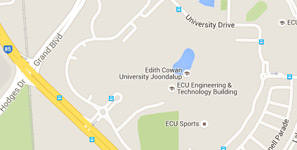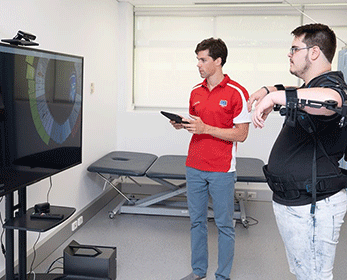The Neurorehabiitation and Robotics Laboratory conducts high-impact translational research that aims to understand and better leverage the mechanisms underlying recovery of function after neurological injury, increase engagement in rehabilitation, and improve rehabilitation outcomes. Our research focuses on understanding and promoting neuroplasticity following neurological damage caused by stroke, spinal cord injury, or other brain injuries. We use advanced robotic technologies combined with non-invasive brain stimulation techniques and other technologies to improve voluntary movement and motor function. Scientists in the lab engage in national and international collaborations through government, non-profit, and industry-supported research projects with the goal of generating new knowledge that will have meaningful impacts for patients, clinical practice, and neurorehabilitation research.
The main research themes are:
- To investigate human voluntary movement, central nervous system function, and functional recovery following neurological damage.
- To identify predictors of rehabilitation outcomes.
- To assess effectiveness of robotic technologies, non-invasive brain stimulation, and combinatorial therapies on patient outcomes.
- To assess cognitive, sensory, and motor mechanisms underlying neuro-rehabilitation.
For more information, contact Prof Dylan Edwards or Dr Onno van der Groen
Current Projects
- Low-intensity rTMS in human spinal cord injury: a translational approach
- Improving recovery after spinal cord injury
- Combining rehabilitation robotics and a virtual dolphin game to improve arm function in stroke survivors
- Predicting motor outcomes in stroke using state-of-the-art technology
- Contralateral effects of eccentric resistance training on muscle function of impaired arm of stroke patients
- Examining the potential use of transcranial random noise stimulation for neurorehabilitation
Media Releases
- Clinical Neuroscience and adjuncts to rehabilitation robotics
- Robotics for neurorehabilitation
- Like to work with background noise? It could be boosting your performance
- ECU participants needed for stroke study
- Changing lives one robot at a time
Lead
Professor Dylan Edwards
Research Fellow
Dr Onno van der Groen
Research Assistant
Kirsten van Rijn
Postgraduate student project opportunities
- Low-intensity rTMS in human spinal cord injury: a translational approach
- Combining rehabilitation robotics and a virtual dolphin game to improve arm function in stroke survivors
- Contralateral effects of eccentric resistance training on muscle function of impaired arm of stroke patients
For more information about these opportunities, visit our Higher Degree by Research webpage.
Key Publications (last 5 years)
- Van der Groen, O., Potok, W., Wenderoth, N., Edwards, G., Mattlingley, J.B., Edwards, D.: Using noise for the better: The effects of transcranial random noise stimulation on the brain and behavior. Neurosci Biobehav Rev. 2022 May 17;138:104702 (in press) https://doi.org/10.1016/j.neubiorev.2022.104702
- Edwards, D.J., Forrest, G., Cortes, M., Weightman, M.M., Sadowsky C., Chang, S-H., Furman, K., Bialek, A., Prokup, S., Carlow, J., VanHiel, L., Kemp, L., Musick, D., Campo, M., Jayaraman, A.: Walking improvement in chronic incomplete spinal cord injury with exoskeleton robotic training (WISE): a randomized controlled trial. Spinal Cord. 2022. doi: 10.1038/s41393-022-00751-8.
- Bowren, M. Jr, Bruss, J., Manzel, K., Edwards, D., Liu, C., Corbetta, M., Tranel, D., Boes, A.D.: Post-stroke outcomes predicted from multivariate lesion-behaviour and lesion network mapping. Brain, 2022, awac010, https://doi.org/10.1093/brain/awac010
- Moretti, C.B., Hamilton, T., Edwards, D.J., et al.: Robotic Kinematic measures of the arm in chronic Stroke: part 2 – strong correlation with clinical outcome measures. Bioelectron Med, 7:21, 2021 https://doi.org/10.1186/s42234-021-00082-8
- Moretti, C.B., Edwards, D.J., Hamilton, T., et al.: Robotic Kinematic measures of the arm in chronic Stroke: part 1 – Motor Recovery patterns from tDCS preceding intensive training. Bioelectron Med, 7:20, 2021 https://doi.org/10.1186/s42234-021-00081-9
- Potok, W., van der Groen, O., Bachinger, M., Edwards, D., Wenderoth, N.: Transcranial random noise stimulation modulates neural processing of sensory and motor circuits - from potential cellular mechanisms to behaviour: a scoping review. eNeuro, 248-21, 2021 https://doi.org/10.1016/j.brs.2021.12.001
- Cramer, S.C., Le, V., Saver, J.L., Dodakian, L., See, J., Augsburger, R., McKenzie, A., Zhou, R.J., Chiu, N.L., Heckhausen, J., Cassidy, J.M., Scacchi, W., Smith, M.T., Barrett, A.M., Knutson, J., Edwards, D., Putrino, D., Agrawal,K., Ngo, K., Roth, E.J., Tirschwell, D.L., Woodbury, M.L., Zafonte, R., Zhao, W., Spilker, J., Wolf, S.L., Broderick, J.P., Janis, S.: Intense Arm Rehabilitation Therapy Improves the Modified Rankin Scale Score: Association Between Gains in Improvement and Function. Neurology, 96(14):e1812-e1822, 2021 PMID: 33589538 doi:10.1212/WNL.0000000000011667
- Edwards, D.J. Critically appraised paper: Noninvasive brain stimulation does not enhance the effect of robotic-assisted upper limb training on arm motor recovery after stroke [invited commentary]. Journal of Physiotherapy, 67(3):218, 2021 doi: 10.1016/j.jphys.2021.05.007. PMID: 34059476
- Park, C., Oh-Park, M., Bialek, A., Friel, K., Edwards, D., You, J.S.H.: Abnormal synergistic gait mitigation after acute stroke using an innovative ankle-knee-hip interlimb humanoid robot: A randomized controlled preliminary trial. Scientific Report, 11(1):1-13, 2021
- Wortman-Jutt, S., van der Groen, O., Edwards, D. (2020). Non-invasive brain stimulation in human stroke survivors (in press). Neurovascular Neuropsychology.
- Wuennemann, M., Mackenzie, S., Lane, H., Peltz, A., Ma, X., Gerber, L., Edwards, D. Kitago, T. Dose and staffing comparison study of upper limb-device-assisted therapy. NeuroRehabilitation: an interdisciplinary journal, 46, 287-297, DOI:10.3233/NRE-192993
- Tozlu, C., Edwards, D., Boes, A., Labar, D., Tsagaris, K., Silverstein, J., Lane, H., Sabuncu, M., Liu, C., & Kuceyeski, A. (2020). Machine learning methods predict individual upper-limb motor impairment following therapy in chronic stroke. Neurorehabilitation and Neural Repair, 10.1177/1545968320909796
- Edwards, D., Cortes, M., Rykman-Peltz, A., Chang, J., Elder, J., Thickbroom, G., Mariman, J., Gerber, L., Oromendia, C., Krebs, H., Fregni, F., Volpe, B., Pascual-Leone, A. (2019). Clinical improvement with intensive robot-assisted arm training in chronic stroke is unchanged by supplementary tDCS. Restorative Neurology and Neuroscience, 37(2): 167-180, DOI 10.3233/RNN-180869
- Santos, T., & Edwards, D. (2019). Non-invasive brain stimulation to treat disorders of human verticality. Neurologie and Rehabilitation, 25, S50-S53, DOI 10.14624/NR1904011
- Silverstein, J., Cortes, M., Tsagaris, K., Climent, A., Gerber, L, Oromendia, C., … & Edwards, D. Paired associative stimulation as a tool to assess plasticity enhancers in chronic stroke. Frontiers in Neuroscience, 13, Article 792, 10.3389/fnins.2019.00792
- Santos, T., Baggio, J., Rondinoni, C., Machado, L., Weber, K., Stefano, … & Edwards, D. (2019). Fractional anisotropy of thalamic nuclei is associated with verticality misperception after extra-thalmic stroke. Frontiers in Neurology, 10, Article 697, 10.3389/fneur.2019.00697
- Santos, T., Favoretto, D., Toostani, I., Nascimento, D., Rimoli, B., Bergonzoni, E, … & Edwards, D. (2018). Manipulation of human verticality using high-definition transcranial direct current stimulation. Frontiers in Neurology, 9, Article 825, DOI 10.3389/fneur.2018.00825
- Buchwald, A., Falconer, C., Rykman-Peltz, A., Cortez, M., Pascual-Leone, A., Thickbroom, G., …& Edwards, D. (2018). Robotic arm rehabilitation in chronic stroke patients with Aphasia may promote speech and language recovery (but effect is not enhanced by supplementary tDCS). Frontiers in Neurology, 9, Article 852, DOI 10.3389/fneur.2018.00853
- Cortes, M., Medeiros, A., Gandhi, A., Lee, P., Krebs, H., Thickbroom, G., & Edwards, D. (2017). Improved grasp function with transcranial direct current stimulation in chronic spinal cord injury. NeuroRehabilitation: an interdisciplinary journal, 41(1): 51-59. 10.3233/NRE-171456

